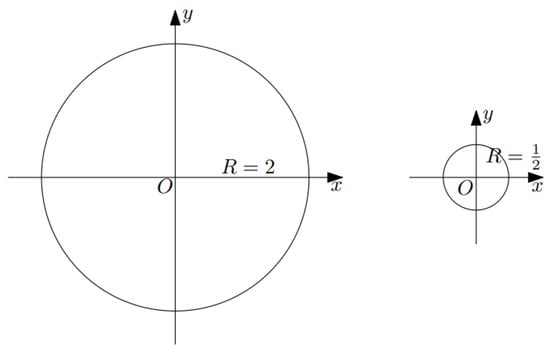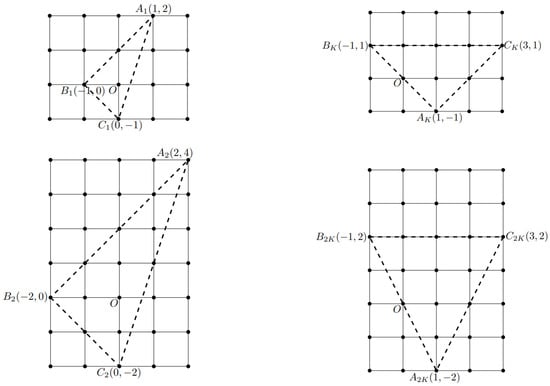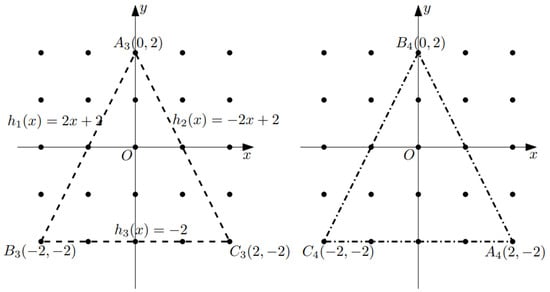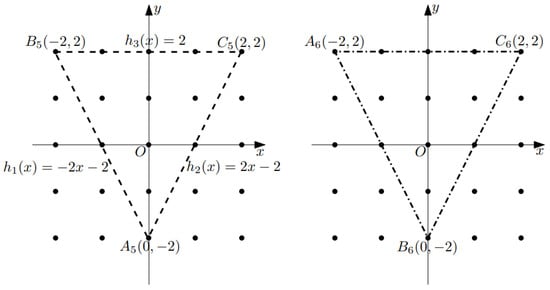Abstract
The discrete Legendre transform is a powerful tool for analyzing the properties of convex lattice sets. In this paper, for , we study a class of convex lattice sets and establish a relationship between vertices of the polar of convex lattice sets and vertices of the polar of its dilation. Subsequently, we show that there exists a class of convex lattice sets such that its polar is itself. In addition, we calculate upper and lower bounds for the discrete Mahler product of a class of convex lattice sets.
MSC:
52C07; 11H06; 52B20
1. Introduction
We denote by the n-dimensional Euclidean space. A convex body C in is a compact convex subset with a nonempty interior. If a convex body C contains the origin in its interior, then the polar body is defined by
where denotes the standard inner product of x and y in . For instance, the polar body of a origin-symmetric circle with a radius of 2 is the origin-symmetric circle with a radius of in . See Figure 1.

Figure 1.
Origin-symmetric circle with radius of 2 and its polar.
The famous Blaschke–Santaló inequality in convex geometry provides a relationship between and . It asserts that
with equality if and only if K is an ellipsoid [1]. Here, denotes the volume in .
For , the inequality was proven by Blaschke [2], and later, it was generalized to higher dimension by Santaló [3]. The case of equality was characterized by Petty [4]. The Blaschke–Santaló inequality has been extensively studied, see, e.g., [5,6,7].
Blaschkle–Santaló inequality considers the upper bound for in . For the discrete setting, we consider the finite sets of integer lattice points which are necessarily full-dimensional unless indicated otherwise. A fundamental problem in the discrete setting is to establish the lower and upper bounds for the number of integer lattice points, see, e.g., [8,9]. More information about integer lattice points can be found in [10,11,12,13,14].
Let be the set of integer lattice in , i.e., the lattice of all points with integer coordinates. Let K be a finite set in . We say that K is a convex lattice set if
where denotes the convex hull of K. We denote by the lattice point enumerator for convex lattice sets. Let be the discrete Mahler product of convex lattice set K, where denotes the polar of convex lattice set K in (see Definition 1).
The Legendre transform is a classical and powerful tool in mathematics. In the discrete case, Murota considered the discrete Legendre transform in [15,16]. Let be proper and convex, then the discrete Legendre transform is defined by
where and denotes supremum.
The paper is organized as follows. In Section 2, for , we study a class of convex lattice sets and establish a relationship between the vertices of and the vertices of . Furthermore, we consider a specific class of convex lattice sets that satisfy . Additionally, we derive the upper and lower bounds for the discrete Mahler product of a class of convex lattice sets.
2. Properties of Convex Lattice Sets
Denote by the set of all convex lattice sets containing the origin. For , let , where vert means vertices.
Polytopes can be characterized through two distinct methods. If a polytope is given as the bounded intersection of finitely many closed halfspaces, then it is called an H-polytope [1,17]. Assume that the hyperplane can be written in the form
with for . We turn to a subclass of , consisting of all convex lattice sets in , generated by the hyperplane , that include the origin, which will be denoted by . For , it is generated by
where denotes the closed halfspace bounded by .
Clearly, represents the boundary of . In special cases, points in the convex lattice set K may lie on . Any point in the convex lattice set K is a lattice point with integer coordinates. Based on coefficients of , when are integers, we can deduce that value of , i.e., the is an integer.
A polytope given as the convex hull of finitely many points is called a V-polytope [1,17]. Let . Assume that , then
where with for .
For , the discrete Legendre transform is given by
for .
The process can be found in [18]. Next, we introduce a lemma for the convex function.
Lemma 1
([19]). Let f be a finite convex function on a convex set . Then, the function
is a proper convex function in .
Obviously, by Lemma 1, is a proper convex function in .
Let . Then, for , we obtain that . Assume that
with for , .
Next, we can propose a definition of polar body of convex lattice sets K in .
Definition 1.
The polar of convex lattice set K in is defined by
In fact, Definition 1 is equivalent to the definition of polar of convex lattice sets in [18]. In [18], He and Si provide the definition of the polar of a convex lattice set K in and , where denotes the set of n-tuple arrays of rational numbers, that is, the set of points with rational coordinates.
We give a simple example of the definition of the polar of a convex lattice set K.
Example 1.

Let , . Clearly, we obtain that K is bounded by the following hyperplanes
Then, by (1) and Definition 1, we obtain that
See Figure 2.

Figure 2.
K, (from left).
Let . For any convex body C that contains the origin as its interior, its polar body satisfies the property . In the subsequent discussion, we consider a similar property of convex lattice sets, i.e., the relation between and .
Theorem 1.
If , , then can be obtained by multiplying the n-th coordinate component of each point in by a factor of t, where denotes the set of positive integers.
Proof.
According to the sign characteristics of coordinates, we divide into the following blocks:
Let the vertices of convex lattice set K be , where with for .
Assume that K is bounded by the hyperplanes as follows
with for , .
Clearly, by Definition 1, we obtain that
Let
Obviously, .
For , it is easy to obtain that . Then, . For the blocks and where , we know that the hyperplanes of the boundary enclosing can be obtained by translation of the hyperplanes of the boundary enclosing K. In other words, in and where , the coefficients of the hyperplanes of the boundary enclosing is equal to the coefficients of the hyperplanes of the boundary enclosing K.
Therefore, we assume that is bounded by the hyperplanes as follows:
where for , .
Let , and then for , . Consequently, we have
and then, we obtain that
It follows from that
Then, we have
Therefore, we obtain that
where for , .
Similar to (4), we have
Let
Obviously, .
Remark 1.
Let t be a positive rational number denoted by with for , where denotes the greatest common divisor. If the common divisor of
is q, then the relation between and satisfies Theorem 1.
We illustrate Theorem 1 with an example in .
Example 2.

Let , . The vertices of K are . Then, we can obtain that
Therefore, we obtain that can be obtained by multiplying the second coordinate component of each point in by a factor of 2. See Figure 3.

Figure 3.
K (top left), (top right), (bottom left), (bottom right).
Next, in order to prove the relation between and K, we introduce a special class convex lattice sets.
Assume that K is bounded by the following hyperplanes
or
with , .
For K, it is generated by the hyperplanes (7) or (8), and then, we have . The result is summarized in the following theorem.
Proof.

Without loss of generality, assume that K is bounded by the following hyperplanes
where .
Let for . Summarizing the above arguments, we obtain Table 1.

Table 1.
The coefficients of hyperplanes of K.
Without loss of generality, we take . According to sign characteristics of coordinates, we obtain that .
Indeed, if K is bounded by the hyperplanes (9), then , which is equivalent to . For , we have . Therefore, by Table 1, in , we obtain that
By summing over (11), we have
Therefore, when , we have
with , , .
If is bounded by the hyperplanes (14), then .
Similarly, if is bounded by the hyperplanes (8), then . □
We illustrate Theorem 2 with an example in .
Example 3.

Let , . By (14), we see that K is bounded by the following hyperplanes
Therefore, it is easy to obtain that ,
Obviously, . See Figure 4.

Figure 4.
K, (from left).
Remark 2.

In Theorem 2, we demonstrated the situation where K is bounded by the hyperplanes (7). To illustrate the case where K is bounded by the hyperplanes (8), we now provide a simple example in .
Let , . By (8), assume that K is bounded by the following hyperplanes
Then, we obtain that ,
Clearly, . See Figure 5.

Figure 5.
K, (from left).
Indeed, the definition of K indicates that K is bounded by the intersection of finitely many closed halfspaces. Assume that
with for .
In the following, we focus on a specific subclass of , which comprises all convex lattice sets in formed by the intersection of hyperplanes that include the origin as its interior. Specifically, this subclass is defined as the intersection of with the union of two sets,
and will be denoted by .
In order to provide the upper and lower bounds for the discrete Mahler product of convex lattice sets, we need the following lemmas.
Lemma 2
([20]). For any origin-symmetric convex body K, we have
where , and denotes the n-dimensional Euclidean unit ball.
Lemma 3
([18]). If and K is origin-symmetric, then K is a cross-polytope that holds if and only if the discrete Mahler product is the smallest.
We now prove the upper and lower bounds for the discrete Mahler product of convex lattice sets. (The discrete Mahler product considers the relationship between and in . For convex body K, is referred to as the Mahler product. The Mahler conjecture [21] is an open question that proposes the lower bound for .)
Theorem 3.
If is origin-symmetric, then the upper and lower bounds of the discrete Mahler product of K are
Proof.
Let be origin-symmetric. Then, we assume that is bounded by the following hyperplanes
with for .
Therefore, for , we have
and then, we let and , where for , .
Let be the cross-polytope. Obviously, . Then, we have
A cross-polytope is a specific type of polytope, and its polar body is indeed a cube. By Lemma 3, the smallest discrete Mahler product can be calculated by
In particular, when and , it is easy to obtain . We now separate the situation into three cases.
Case 1:
Obviously, for , , we obtain that .
Case 2:
Fix . For is origin-symmetric, we see that is a contradiction.
Case 3:
For , it is easy to obtain .
By the above arguments, for , we have . Therefore, by the definition of polar body of convex body, we obtain that
and then, we have
By Lemma 2 and (16), we obtain that
By the definition of , the upper bound of is an n-dimensional cube with edge length , that is, when ,
Then, we can see that
Consequently, we have
Therefore, we have
and then, the upper and lower bounds for are given by
□
3. Conclusions
The discrete Legendre transform is a mathematical operation in various fields such as signal processing, economics, and game theory. The discrete Legendre transform is an active filed of research, especially in economics and game theory, see, e.g., [22], or discrete convex analysis, see, e.g., [15,23]. It is worth noting that the discrete Legendre transform is relevant to image processing, such as in image compression [24] and image encoding [25]. Moreover, it also serves as a critical method for analyzing the properties of convex lattice sets. Within the context of this study, for , we study a class of convex lattice sets and establish a relationship between and . More precisely, we obtain that the vertices of derived by scaling the n-th coordinate component of each vertex in by a factor of t. This discovery provides a deeper understanding of how the scaling of a lattice set impacts the polar of convex lattice set. Subsequently, we turn our attention to a specific class of convex lattice sets that is distinguished by the property . The class of convex lattice sets is characterized by the presence of a bounding hyperplane , where , and the fact that all other bounding hyperplanes intersect the -axis at the same point. The study of the number of lattice points has always been a focus of public attention. Next, we consider the upper and lower bounds of the discrete Mahler product for convex lattice sets. When the discrete Mahler product reaches its upper bound, the convex lattice set K is a cross-polytope. The lower bound of the discrete Mahler product is a fraction related to the constant c and the volume of the unit sphere.
Author Contributions
Conceptualization and methodology, L.S.; writing—original draft preparation, T.H.; writing—review and editing, R.Y. All authors have read and agreed to the published version of the manuscript.
Funding
This research is partially supported by Analysis and Research on Innovative Training Strategies for Mathematical Fundamentals of Beijing Forestry University.
Data Availability Statement
Data are contained within the article.
Conflicts of Interest
The authors declare no conflicts of interest.
References
- Matoušek, J. Lectures on Discrete Geometry; Springer: New York, NY, USA, 2002; pp. 320–321. [Google Scholar]
- Blaschkle, W. Über Affine Geometrie vii: Neue Extremeigenschaften von Ellipse and Ellipsoid. Leipz. Berichte 1917, 69, 306–318. [Google Scholar]
- Santaló, L.A. Un invariante affine para los cuerpos convexos del espacio de n dimensiones. Port. Math. 1943, 8, 155–161. [Google Scholar]
- Petty, C.M. Affine isoperimetric problems. Ann. N. Y. Acad. Sci. 1985, 440, 113–127. [Google Scholar] [CrossRef]
- Hug, D. Contributions to affine surface area. Manuscr. Math. 1996, 91, 283–301. [Google Scholar] [CrossRef]
- Meyer, M.; Pajor, A. On the Blaschkle-Santaló inequality. Arch. Math. 1990, 55, 82–93. [Google Scholar] [CrossRef]
- Haddad, J.; Jiménez, H.; Montenegro, M. Asymmetric Blaschke-Santaló functional inequalities. J. Funct. Anal. 2020, 278, 108319. [Google Scholar] [CrossRef]
- Zaks, J.; Perler, M.A.; Wills, J.M. On lattice polytopes having interior lattice points. Elem. Math. 1982, 2, 44–46. [Google Scholar]
- Henk, M.; Henze, M.; Wills, J.M. Blichfeldt-type inequalities and central symmetry. Adv. Geom. 2011, 11, 731–744. [Google Scholar] [CrossRef]
- Gardner, R.J.; Gritzmann, P. Discrete tomography: Determination of finite sets by X-rays. Trans. Amer. Math. Soc. 1997, 349, 2271–2295. [Google Scholar] [CrossRef]
- Gardner, R.J.; Gronchi, P. A Brunn-Minkowski Inequality for the integer lattice. Trans. Amer. Math. Soc. 2001, 353, 3995–4024. [Google Scholar] [CrossRef]
- Bogachev, L.V.; Zarbaliev, S.M. Inverse Limit Shape Problem for Multiplicative Ensembles of Convex Lattice Polygonal Lines. Mathematics 2023, 11, 385. [Google Scholar] [CrossRef]
- Ansgar, F.; Eduardo, L. Interpolating between volume and lattice point enumerator with successive minima. Monatsh. Math. 2022, 198, 717–740. [Google Scholar]
- Henk, M.; Schymura, M.; Xue, F. Packing minima and lattice points in convex bodies. Mosc. J. Comb. Number Theory 2021, 10, 25–48. [Google Scholar] [CrossRef]
- Maehare, T.; Murota, K. A framework of discrete DC programming by discrete convex analysis. Math. Program. 2015, 152, 435–466. [Google Scholar] [CrossRef]
- Murota, K. Discrete Convex Analysis. Math. Program. 1998, 83, 313–371. [Google Scholar] [CrossRef]
- Schneider, R. Convex Bodies: The Brunn-Minkowski Theory, 2nd ed.; Cambridge University Press: Cambridge, UK, 2013; pp. 36–39. [Google Scholar]
- He, T.; Si, L. The Legendre transform of convex lattice sets. arXiv 2024, arXiv:2405.18104. [Google Scholar]
- Adivar, M.; Fang, S.C. Convex Analysis and Duality over Discrete Domains. J. Oper. Res. Soc. China 2018, 6, 189–247. [Google Scholar] [CrossRef]
- Gillet, H.; Soulé, C. On the number of lattice points in convex symmetric bodies and their duals. Israel J. Math. 1991, 74, 2–3. [Google Scholar] [CrossRef]
- Lopez, M.A.; Reisner, S. A Special Case of Mahler’s Conjecture. Discret. Comput. Geom. 1998, 20, 163–177. [Google Scholar] [CrossRef]
- Murota, K. Discrete Convex Analysis: A Tool for Economics and Game Theory. J. Mech. Instit. Des. 2016, 1, 151–273. [Google Scholar] [CrossRef]
- Murota, K.; Tamura, A. Discrete Fenchel duality for a pair of integrally convex and separable convex functions. Jpn. J. Ind. Appl. Math. 2022, 39, 599–630. [Google Scholar] [CrossRef]
- Lazaridis, P.; Bizopoulos, A.; Tzekis, P.; Zaharis, Z.; Debarge, G.; Gallion, P. Comparative study of DCT and discrete Legendre transform for image compression. In Proceedings of the 10th International Conference on Electronics, Telecommunications, Automatics and Informatics (ETAI 2011), Ohrid, Macedonia, 16–20 September 2011. [Google Scholar]
- Rayess, D.M.E.; Ghoniemy, S.; Bahgat, S.F. Digital image coding using legendre transform. Circuits Syst. Signal Process. 1994, 13, 3–18. [Google Scholar] [CrossRef]
Disclaimer/Publisher’s Note: The statements, opinions and data contained in all publications are solely those of the individual author(s) and contributor(s) and not of MDPI and/or the editor(s). MDPI and/or the editor(s) disclaim responsibility for any injury to people or property resulting from any ideas, methods, instructions or products referred to in the content. |
© 2024 by the authors. Licensee MDPI, Basel, Switzerland. This article is an open access article distributed under the terms and conditions of the Creative Commons Attribution (CC BY) license (https://creativecommons.org/licenses/by/4.0/).